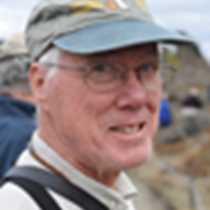Sitkoh Bay and Chatham Strait, Southeast Alaska
Sitka was Alaska's capital during Russian times. In 1867, the transfer of Alaska from Russia to America occurred here. Alaska's capital remained in Sitka until 1900, when it moved to Juneau. Yesterday we boarded the National Geographic Sea Bird in Sitka, and our trip among the islands of beautiful Southeast Alaska was underway. It was a fine night (such night as there is at this northern latitude) for standing on the deck watching Alaska go by. Sitka black-tailed deer were spotted through the window of the dining room, and we had our first encounter with a brown bear foraging in a coastal meadow, regally ignoring our presence.
We made our way through narrow Sergius Narrows where the current rages with each changing tide. This morning we were in Sitkoh Bay, near the southeast corner of Chichagof Island. We donned our beloved rubber boots and headed ashore for a walk through the forest, and kayak or Zodiac over the water. The forest behind the beach landing has been largely undisturbed since it grew after the last retreat of glacial ice, some 12,000 years ago, but we saw stumps left from early 20th century hand logging of massive Sitka spruce trees. This form of logging was selective and limited to areas near the beach.
Behind the beach were areas where, more recently, the forest was clear cut, every tree felled and removed and the forest left to regenerate naturally, but slowly. Bear trails and logging roads provided easy access to the forest as we stretched our legs to remove the lingering effects of travel. Ferns, mosses, and small flowering plants form a rich understory under the forest canopy high above us. Occasional piles of scat along the trail indicate that we share the forest with brown bears. In fact, bears were seen both by Zodiac cruisers and by long hikers.
Our afternoon was spent aboard ship moving northward, always searching for marine mammals. Black and white Dall's porpoise sent up rooster tails of water as they zoomed about us. Some came to hitch a ride on the pressure wave created by the ship's bow, and we could hang over the bow and look down at them. They were an interesting diversion as we searched for humpback whales. At last, we spotted tall spouts hanging in the still air. The humpback whales of Alaska have only recently returned from their winter in Hawaii. Now they are feeding in Alaska's productive seas to replenish the layer of energy-rich blubber that was depleted in Hawaii and on the long journey north. Again and again, the whales came to the surface, breathing several times to restore the oxygen in their tissues, and then they dove, seeking schools of fish to engulf in a giant mouthful.
We watched two whales quite close to the ship, and saw the pattern of black and white on the underside of the flukes as the whales descended. Each pattern is unique, allowing researchers to identify individual whales and follow their movements and behavior. Off in the distance a whale repeatedly slapped the water with its long pectoral fins. Then, screams of glee rang out as a distant whale burst from the water and went airborne before turning and falling back with a mighty splash. None can tell just why humpback whales engage in this acrobatic behavior, but is was something that we had hoped to witness and a fine start to our voyage in beautiful Southeast Alaska.




